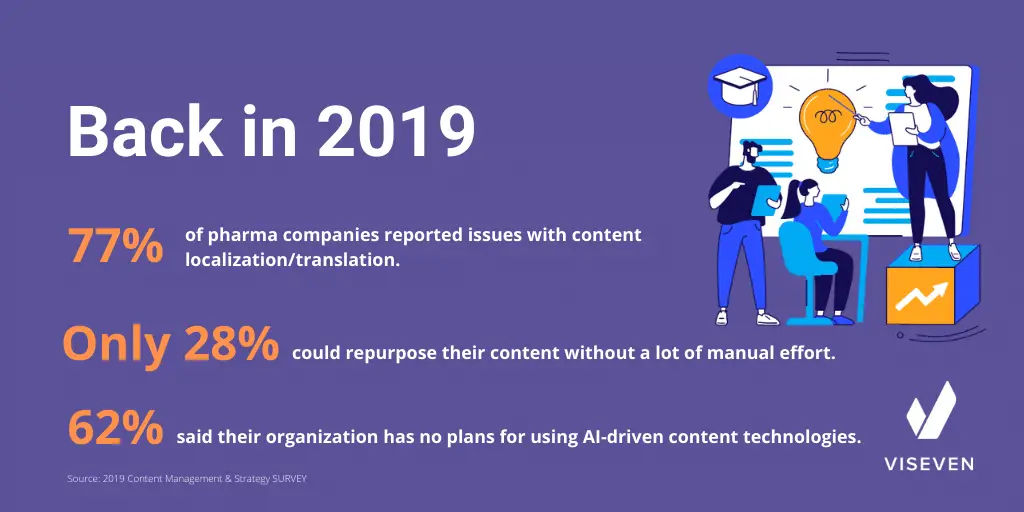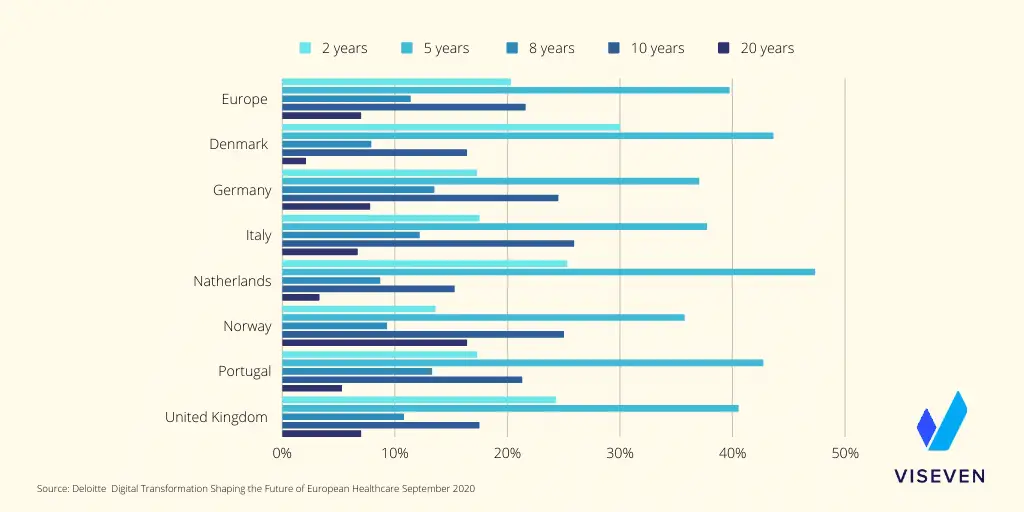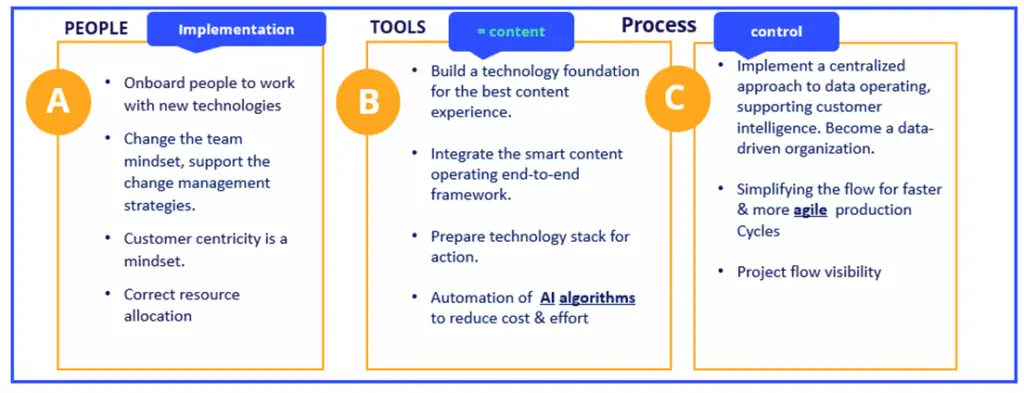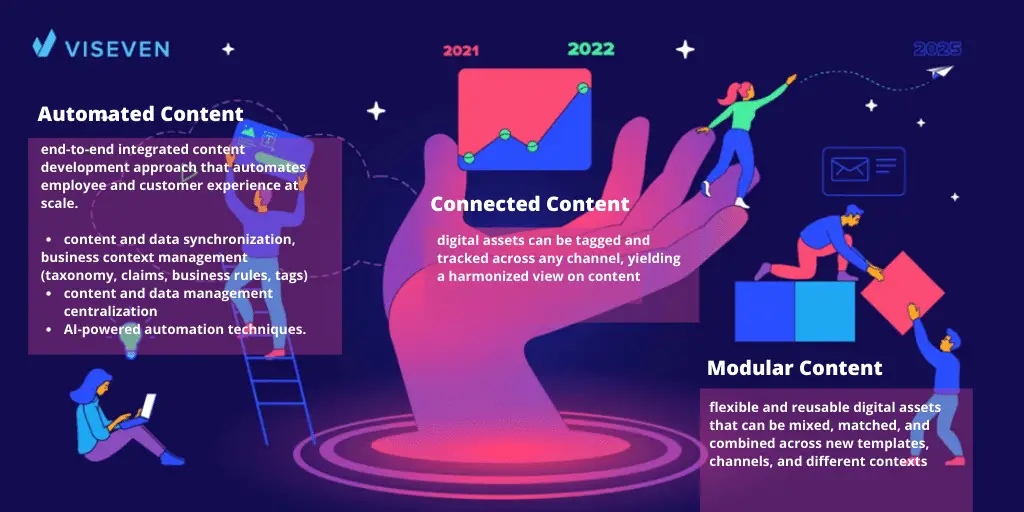The Milestones of Digital Transformation in Pharma: Evolution of Content Experience
From time to time, pharma gets under the fire due to its excessive talks about ‘digital transformation’. It’s not quite clear what these words refer to and whether these grandiloquent statements are working for actual doctors and patients. How many healthcare professionals and patients have yet seen the impact of the great transformation in pharma? Has it already improved pharma’s daily operations?
Let’s try to figure out where the pharma industry is on the road to digitalization, how this process is changing the way they do business, and how it affects the HCPs and patients’ engagement.
What is Digital Transformation – why we should take this path
“Every digital transformation is going to begin and end with the customer, and I can see that in the minds of every CEO, I talk to.” – Marc Benioff, Chairman, and Co-CEO, Salesforce.
Technology pushes us to change, poses challenges we don’t want to take, makes us move forward. These changes may be dramatic. But when life wants us to grow, it makes us change.
The problem is that technology is changing faster than we are, leaving us with no other choice but to keep pace.
When we speak of digital transformation, we mean the natural evolution of existing processes with new technologies, the introduction of patterns and strategies that allow to enhance customer experience and build a genuine dialogue with the customer.
In pharma, this process was launched two years ago, when the pandemic, without much readiness, forced life sciences to drastically increase their digital culture or, in particular cases, grow it from scratch. Looking back, we may go through all cliches of that period, but the digital shift declared a standard of communication with customers.
The impact of the digital shift in pharma
- In-person engagement
- One-size-fits-all strategies
- Disconnected communication with customers
- Lack of consistent processes
- Non-reusability of digital assets
- Lack of clear messaging
- Complex Approvals
- Lack of collaboration between global teams
- Mix of virtual and hybrid engagement
- Solutions tailored to the customers’ needs
- Holistic communication across multiple channels
- Strategic approach to content management
- Reusable digital assets
- Streamlined MLR process
- Scalability of the implemented solutions
Can we hold the transformation back?
Remember your life before the pandemic, now it seems like a dream to you, right? Like no others, these two years had a major impact on our lives, habits, and priorities.
Back in 2019, marketers expected a quick end of the pandemic and a return to routine communication with customers. After two tears, again like dream, the pandemic is slowly receding (at the least restrictions). It begs the question: do we need to digitalize further? And will this process be slowed down now?
No. Because, in fact, the digital shift catalyzed some fundamental changes.
Pharma marketing has always been a complicated environment, characterized by complicated relationships with its target audience. However, the shift towards digital has exposed many problems that previously couldn’t be tracked.
Searching through the old reports is like getting into a time machine which can take us back to changes that have taken place. The retrospective looks as follows: In 2019, 77% of pharma companies reported issues with content localization/translation. Only 28% could repurpose their content without a lot of manual effort. Back then, 62% say their organization has no plans for using AI-driven content technologies.
The greatest impact of the digital shift had on HCP engagement. Before COVID-19, 64% of meetings with pharma sales reps were held in person. During the pandemic, this shifted to 65% of meetings held virtually.

The old patters revolve primarily around internal issues of content production in pharma and don’t consider the main factor – HCP’s experiences. Today, the search for personalized experiences for the customer is the cornerstone of all companies that want to withstand competition in the market and have a serious competitive advantage.
In the end, we shouldn’t forget that technology exists to make our life easier. In life sciences, the ultimate goal of Digital Transformation is to introduce new technologies that will allow space and time for more strategic decisions on customers. These technologies should solve the long-standing issues of MLR optimization, content and taxonomy management, and support of the multivendor environment.
Has the digital moment arrived in pharma?
Where are we now on the road to digital success? Despite being spurred by the pandemic; the process of digitalization doesn’t exactly run fast. In terms of digitalization, there are still many regions on the map where companies’ digital development level is consistently low. This map shows how pharma companies across the world currently assess their readiness to become a fully digital organization.

According to this map, the digitalization process among countries remains uneven. This primarily associated with poor scalability of implemented solutions among the regions and resilience to changes. Now, 1/3 of pharma believe they are poorly resourced for digital engagement. The other 40% report the lack of talent and right technology for transformation.
It’s important to understand that each industry has its own specifics and digitalization in pharma won’t be that smooth like anywhere else. However, this process highlights the areas where the change of mindset should happen and what soft spots digital transformation is designed to cover.
Areas of Digital Transformation: what it refers to
Pharma often speaks clichés, but most critics are associated with a lack of clarification of what it refers to. Pandemic exposed many problems in pharma that, in the new era of communication, cannot remain unresolved. We’ve tried to highlight them all for you to see that Digital Transformation usually touches people, processes, tool, and content, areas where innovations are needed to simplify the internal processes that often hinder the natural evolution of companies towards strategic marketing.

Why do we need it? Communicating with our customers, we should remember that the biggest shift occurred in patients’ mindsets. Not speaking their language, we can compare our audience to distant stars that we try to reach in the dark.
The main driver of prescriptions in pharma is loyalty. The main factor that affects loyalty is the message your brand translates.
Today, advanced content creation technologies give more space for creativity and more strategic decisions on customers. It allows to focus on the emotion brand translates and build a value-based dialogue. For example, executives hope that smart, connected factories could deliver savings of 20% or more.
Digital transformation has given rise to an omnichannel approach that implies an integral dialogue with a modern customer who now wants to communicate with brands on his own terms, choosing the place and time for communication themself.
While omnichannel makes your message live and heard, the introduction of modular content helps pharma to create digital assets that can be reused, eliminating the need for full re-builds, and costly conversions across digital channels.
These innovations would not have been possible without changing mindsets and challenges that always create an opportunity to grow.
The evolution of modular content
The evolution of content production in pharma is associated with a few milestones the introduction of modular, connected, and automated content.
Modular Content is never the ultimate goal. It is one means of many, to provide an excellent customer experience and personalization. It does so by ensuring more consistency, increasing content reuse rates, lowering costs, and speeding time-to-market.
Oksana Matviienko, Key Account Manager, Viseven.
- Modular content has firmly established its positions in a world where patients are especially concerned with their health and the quality of the provided service; and where each pharma strives to become a regular supplier, carefully tailoring their messages to patients’ needs. Modular content is flexible and reusable digital assets in the form of modular units that can be mixed, matched, and combined across new templates, channels, and contexts.
- Connected content has become an evolution towards harmonized view on content with assets being tagged and tracked across any channel. Complete visibility into all versioning provides a means to streamline and accelerate MLR and similar approval processes.
- Automated content is the end-to-end integrated content development approach that automates employee and customer experience at scale. Service concept adopting content and data synchronization, business context management (taxonomy, claims, business rules, tags) via content and data management centralization, and AI-powered automation techniques.

These innovations (among others led by Viseven) make content more efficient, personalized, and most importantly, it allows you to concentrate on your message and deliver content has a meaning to your customers.
Transforming the Global Pharma: Viseven’s approach
Viseven is driving Digital Transformation by offering an end-to-end content operating model that is aligned with strategy, ready for scale and innovation adoption.
We combine both technology and marketing expertise mastering the full chain of enablers to deliver a best-in-class digital experience. Contact us to learn more about how we enable digital transformation for business of all sizes and maturity levels.
The post The Milestones of Digital Transformation in Pharma: Evolution of Content Experience appeared first on Viseven.
